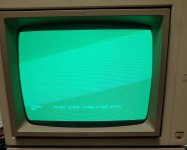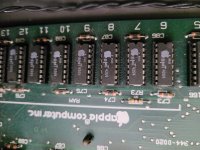ignis-fatuus
Member
- Joined
- Oct 7, 2022
- Messages
- 24
So I've been slowly going through and troubleshooting a recent Apple //e that I picked up on the cheap. It will boot into basic but has difficulty reading floppies. At first I suspected the the power supply, but after opening it up and testing all the caps with an ESR meter, everything checked out (I will do a full cap job ASAP--I did replace one 220 uF@16v that wasn't reading great). Whenever it tries to read floppies it makes a harsh stuttering sound different than the drive initialization noise that accompanies normal disk drive operation. I tried swapping the duodisk for a known working Disk II and I get the same result--the duodisk does work on another machine so I suspected that there is a fault on the motherboard. Please see the following error message which accompanies the attempted reading of a floppy (also note that numbers are different every time but the error message is consistent in its formatting):

Running the self diagnostic I get the following result:

I believe that the error message from the self diagnostic is suggesting that following RAM ICs are bad: F13 F12 F11 F10 F9 F8 F7 F6, which would be all of them...I honestly suspect that multiple RAM ICs have failed, but perhaps not every single one. Perhaps the failed RAM is associated with trouble in disk operation? That is my assumption for now. I am also wary of the fact that the RAM chips are socketed. Just about every IIe board I've seen has the ram soldered into place (did later revisions include sockets by chance?). I was hoping to use some II/IIe diagnostic software I have to help get a better idea what is going on but without working disk drive operation, I am at a bit of a loss.

In thinking toward simply replacing the RAM, I am having some difficulty figuring out a proper replacement. The RAM ICs are labeled MT4246 with the Apple logo. According the data sheet for the IC it says there should be a dash and a number indicating timing speed (-20=200ns, -15=150ns, etc), but as you can see from the picture, no such indicator is provided.
If anyone has any insight toward testing the RAM further and/or finding suitable substitutes, I would be most appreciative.

Running the self diagnostic I get the following result:

I believe that the error message from the self diagnostic is suggesting that following RAM ICs are bad: F13 F12 F11 F10 F9 F8 F7 F6, which would be all of them...I honestly suspect that multiple RAM ICs have failed, but perhaps not every single one. Perhaps the failed RAM is associated with trouble in disk operation? That is my assumption for now. I am also wary of the fact that the RAM chips are socketed. Just about every IIe board I've seen has the ram soldered into place (did later revisions include sockets by chance?). I was hoping to use some II/IIe diagnostic software I have to help get a better idea what is going on but without working disk drive operation, I am at a bit of a loss.

In thinking toward simply replacing the RAM, I am having some difficulty figuring out a proper replacement. The RAM ICs are labeled MT4246 with the Apple logo. According the data sheet for the IC it says there should be a dash and a number indicating timing speed (-20=200ns, -15=150ns, etc), but as you can see from the picture, no such indicator is provided.
If anyone has any insight toward testing the RAM further and/or finding suitable substitutes, I would be most appreciative.


